Land Invertebrates
Media

Species Types
Scientific Name
Charidotella sexpunctata
Description
The golden tortoise beetle is shiny metallic gold or orange, and the edges of the elytral shields are transparent. It eats plants in the morning glory family.
Media
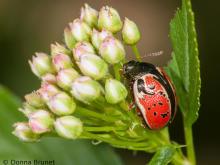
Species Types
Scientific Name
Calligrapha spiraea
Description
The ninebark calligraphy beetle is one of nearly 40 North American calligraphy beetles, named for the scrawly markings on their backs. Most calligraphy beetles require particular host plants.
Media
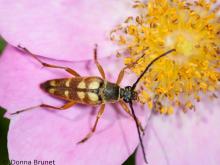
Species Types
Scientific Name
Typocerus velutinus
Description
The banded longhorn is a common species of longhorned beetle. Adults visit flowers for nectar, and larvae feed on decaying oak and hickory wood.
Media
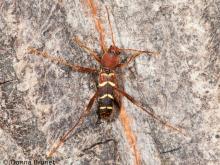
Species Types
Scientific Name
Neoclytus acuminatus
Description
Red-headed ash borers resemble wasps, but they are harmless to people. The colors and markings are distinctive. Their larvae feed on a variety of dead or dying hardwoods, helping the decomposition process and enriching the soil.
Media

Species Types
Scientific Name
Saperda tridentata
Description
The elm borer is a longhorned beetle whose larvae bore galleries under the bark of elm trees. The orangish markings on the adults are distinctive.
Media

Species Types
Scientific Name
Acanthoderes quadrigibba
Description
The four-humped flat-faced longhorn has no true common name, but its markings are distinctive. It plays an important role in breaking down rotten wood and enriching soils.
Media
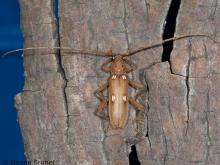
Species Types
Scientific Name
Eburia quadrigeminata
Description
The ivory-marked beetle is a longhorned beetle whose larvae bore deep into the heartwood of a variety of deciduous trees, including oak, hickory, maple, cherry, ash, elm, and more. It can live for 40 years.
Media
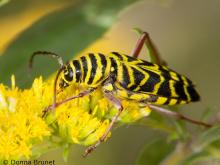
Species Types
Scientific Name
Megacyllene robiniae
Description
The locust borer is a longhorned beetle whose larvae tunnel into the trunks of black locust. The colorful black and yellow adults are often seen in late summer as they feed on the pollen of goldenrod and other flowers.
Media
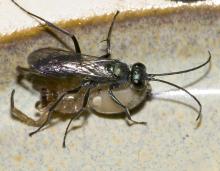
Species Types
Scientific Name
Auplopus spp.
Description
There are 10 species of spider wasps in genus Auplopus in North America north of Mexico. They often snip off the legs of the spiders they capture, which makes them easier to move around.
Media

Species Types
Scientific Name
Tachypompilus ferrugineus
Description
The rusty spider wasp hunts wolf spiders, usually in open areas. Females create nests in rock piles or in cracks in rock walls or foundation stones. Adults are often seen taking nectar from flowers.
See Also



Media

Species Types
Scientific Name
Cisseps fulvicollis
Description
The yellow-collared scape moth is more often “orange-collared.” And whether you think it looks more like a firefly or a wasp, it’s still a moth!
Media

Species Types
Scientific Name
Nearly 150 species in North America north of Mexico
Description
Slim, delicate plume moths are instantly recognizable by their T-shaped silhouette, long legs, and muted shades of tan and brown. It can be hard to separate the various species.
Media

Species Types
Scientific Name
Pyrrharctia isabella
Description
Not many people know the adult Isabella tiger moth when they see one, but we’re all acquainted with its caterpillar, the woolly worm, or woolly bear.
About Land Invertebrates in Missouri
Invertebrates are animals without backbones, including earthworms, slugs, snails, and arthropods. Arthropods—invertebrates with “jointed legs” — are a group of invertebrates that includes crayfish, shrimp, millipedes, centipedes, mites, spiders, and insects. There may be as many as 10 million species of insects alive on earth today, and they probably constitute more than 90 percent all animal species.





















